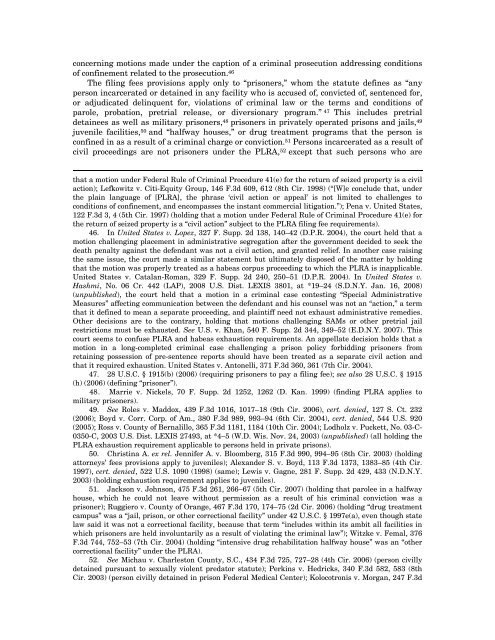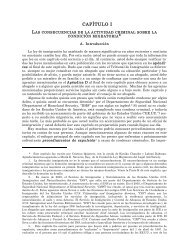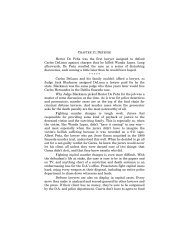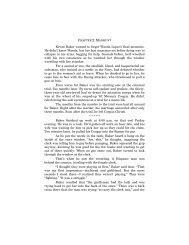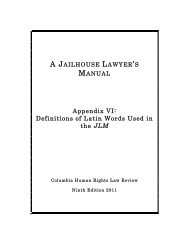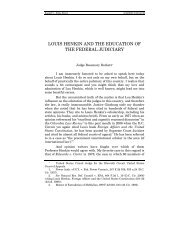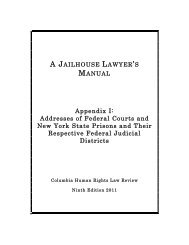A Jailhouse Lawyer's Manual Chapter 14 - Columbia Law School
A Jailhouse Lawyer's Manual Chapter 14 - Columbia Law School
A Jailhouse Lawyer's Manual Chapter 14 - Columbia Law School
Create successful ePaper yourself
Turn your PDF publications into a flip-book with our unique Google optimized e-Paper software.
concerning motions made under the caption of a criminal prosecution addressing conditions<br />
of confinement related to the prosecution. 46<br />
The filing fees provisions apply only to “prisoners,” whom the statute defines as “any<br />
person incarcerated or detained in any facility who is accused of, convicted of, sentenced for,<br />
or adjudicated delinquent for, violations of criminal law or the terms and conditions of<br />
parole, probation, pretrial release, or diversionary program.” 47 This includes pretrial<br />
detainees as well as military prisoners, 48 prisoners in privately operated prisons and jails, 49<br />
juvenile facilities, 50 and “halfway houses,” or drug treatment programs that the person is<br />
confined in as a result of a criminal charge or conviction. 51 Persons incarcerated as a result of<br />
civil proceedings are not prisoners under the PLRA, 52 except that such persons who are<br />
that a motion under Federal Rule of Criminal Procedure 41(e) for the return of seized property is a civil<br />
action); Lefkowitz v. Citi-Equity Group, <strong>14</strong>6 F.3d 609, 612 (8th Cir. 1998) (“[W]e conclude that, under<br />
the plain language of [PLRA], the phrase ‘civil action or appeal’ is not limited to challenges to<br />
conditions of confinement, and encompasses the instant commercial litigation.”); Pena v. United States,<br />
122 F.3d 3, 4 (5th Cir. 1997) (holding that a motion under Federal Rule of Criminal Procedure 41(e) for<br />
the return of seized property is a “civil action” subject to the PLRA filing fee requirements).<br />
46. In United States v. Lopez, 327 F. Supp. 2d 138, <strong>14</strong>0–42 (D.P.R. 2004), the court held that a<br />
motion challenging placement in administrative segregation after the government decided to seek the<br />
death penalty against the defendant was not a civil action, and granted relief. In another case raising<br />
the same issue, the court made a similar statement but ultimately disposed of the matter by holding<br />
that the motion was properly treated as a habeas corpus proceeding to which the PLRA is inapplicable.<br />
United States v. Catalan-Roman, 329 F. Supp. 2d 240, 250–51 (D.P.R. 2004). In United States v.<br />
Hashmi, No. 06 Cr. 442 (LAP), 2008 U.S. Dist. LEXIS 3801, at *19–24 (S.D.N.Y. Jan. 16, 2008)<br />
(unpublished), the court held that a motion in a criminal case contesting “Special Administrative<br />
Measures” affecting communication between the defendant and his counsel was not an “action,” a term<br />
that it defined to mean a separate proceeding, and plaintiff need not exhaust administrative remedies.<br />
Other decisions are to the contrary, holding that motions challenging SAMs or other pretrial jail<br />
restrictions must be exhausted. See U.S. v. Khan, 540 F. Supp. 2d 344, 349–52 (E.D.N.Y. 2007). This<br />
court seems to confuse PLRA and habeas exhaustion requirements. An appellate decision holds that a<br />
motion in a long-completed criminal case challenging a prison policy forbidding prisoners from<br />
retaining possession of pre-sentence reports should have been treated as a separate civil action and<br />
that it required exhaustion. United States v. Antonelli, 371 F.3d 360, 361 (7th Cir. 2004).<br />
47. 28 U.S.C. § 1915(b) (2006) (requiring prisoners to pay a filing fee); see also 28 U.S.C. § 1915<br />
(h) (2006) (defining “prisoner”).<br />
48. Marrie v. Nickels, 70 F. Supp. 2d 1252, 1262 (D. Kan. 1999) (finding PLRA applies to<br />
military prisoners).<br />
49. See Roles v. Maddox, 439 F.3d 1016, 1017–18 (9th Cir. 2006), cert. denied, 127 S. Ct. 232<br />
(2006); Boyd v. Corr. Corp. of Am., 380 F.3d 989, 993–94 (6th Cir. 2004), cert. denied, 544 U.S. 920<br />
(2005); Ross v. County of Bernalillo, 365 F.3d 1181, 1184 (10th Cir. 2004); Lodholz v. Puckett, No. 03-C-<br />
0350-C, 2003 U.S. Dist. LEXIS 27493, at *4–5 (W.D. Wis. Nov. 24, 2003) (unpublished) (all holding the<br />
PLRA exhaustion requirement applicable to persons held in private prisons).<br />
50. Christina A. ex rel. Jennifer A. v. Bloomberg, 315 F.3d 990, 994–95 (8th Cir. 2003) (holding<br />
attorneys’ fees provisions apply to juveniles); Alexander S. v. Boyd, 113 F.3d 1373, 1383–85 (4th Cir.<br />
1997), cert. denied, 522 U.S. 1090 (1998) (same); Lewis v. Gagne, 281 F. Supp. 2d 429, 433 (N.D.N.Y.<br />
2003) (holding exhaustion requirement applies to juveniles).<br />
51. Jackson v. Johnson, 475 F.3d 261, 266–67 (5th Cir. 2007) (holding that parolee in a halfway<br />
house, which he could not leave without permission as a result of his criminal conviction was a<br />
prisoner); Ruggiero v. County of Orange, 467 F.3d 170, 174–75 (2d Cir. 2006) (holding “drug treatment<br />
campus” was a “jail, prison, or other correctional facility” under 42 U.S.C. § 1997e(a), even though state<br />
law said it was not a correctional facility, because that term “includes within its ambit all facilities in<br />
which prisoners are held involuntarily as a result of violating the criminal law”); Witzke v. Femal, 376<br />
F.3d 744, 752–53 (7th Cir. 2004) (holding “intensive drug rehabilitation halfway house” was an “other<br />
correctional facility” under the PLRA).<br />
52. See Michau v. Charleston County, S.C., 434 F.3d 725, 727–28 (4th Cir. 2006) (person civilly<br />
detained pursuant to sexually violent predator statute); Perkins v. Hedricks, 340 F.3d 582, 583 (8th<br />
Cir. 2003) (person civilly detained in prison Federal Medical Center); Kolocotronis v. Morgan, 247 F.3d


